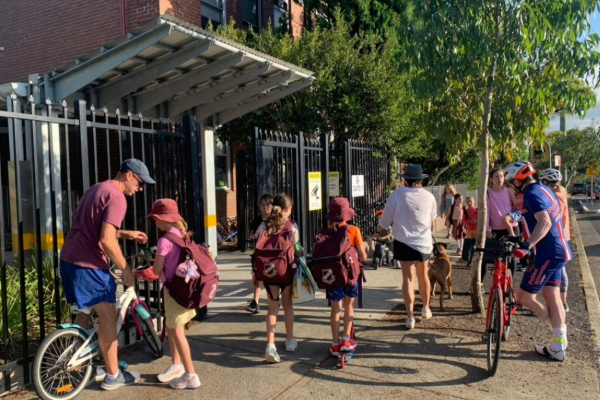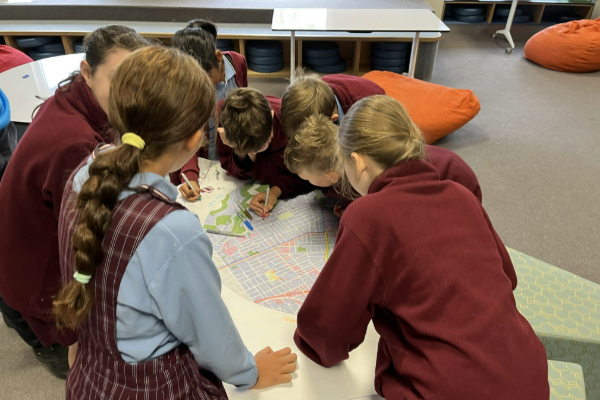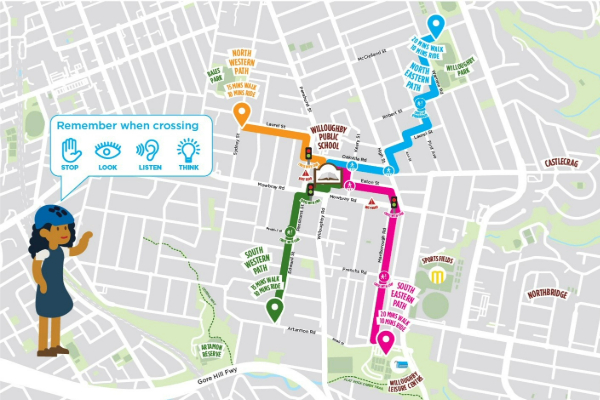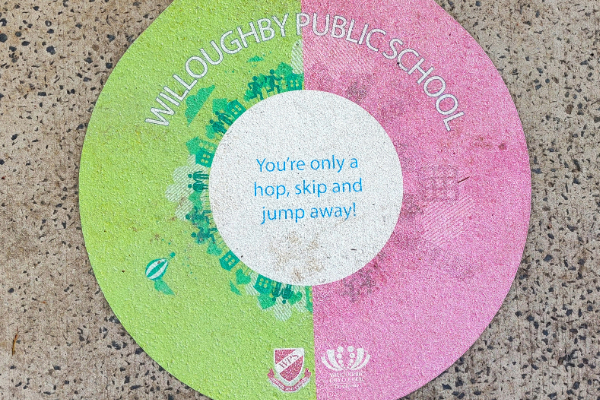Bicycle NSW volunteer Nicolle Kuppens has found bike riding in Sydney a challenge after many years of everyday cycling in the Netherlands. In particular, she is disappointed that it is so difficult for her children to ride to school.
So Nicolle was delighted to learn that her local council, Willoughby on Sydney’s lower north shore, has been running an Schools Active Travel pilot project. She has investigated the history and progress of the project – and the results are fantastic!
The footpaths outside Willoughby Public School are full of active travellers! (Image: Willoughby City Council)
The urgent need to get kids moving
School traffic is the cause of significant congestion on our roads. Every school morning across Sydney a large proportion of children are driven to school. In the 1980s, 75% of children walked or cycled to school. Today only 25% of kids get to class on foot or two wheels. Driving to school represents a missed opportunity for children to demonstrate independence, be outside interacting with friends and neighbours, and move their bodies.
And exercise is so important given high rates of childhood obesity (in 2017, around 1 in 5 NSW children aged 5 to 16 were overweight or obese) and ballooning screen-based recreation (a report from 2015 found that 12–13-year-old Australians spend 30% of their time in front of a screen).
Little action at state level
The first NSW Active Transport Strategy has several actions to double the number of children walking or riding to school. But this isn’t going to happen without significant effort and investment.
In January 2024, the NSW Government has announced a new $10 million Active Transport to School program. The aim of the program is to ‘encourage children to safely walk, scoot or ride their bikes to school’. Transport for NSW developed a questionnaire asking parents to identify problems with accessing school safely. But the real question is: “Is this funding anything near sufficient to improve active transport infrastructure for the 1.2 million school students children in NSW?”
Willoughby takes the lead!
In October 2021, Willoughby City Council launched its ground-breaking Resilience Strategy and Action Plan. The plan identifies the shocks most likely to impact the people of Willoughby. Examples are extreme heat and flooding associated with climate change. Moreover, it responds to underlying stresses such as expensive housing, social isolation, transport congestion and loss of urban tree canopy.
There are 20 high-priority actions to build community resilience. And one of these is:
'Establish Schools Active Travel pilot program in two schools to support more walking and riding to school.'
At this time, Willoughby Public School was desperate to address a number of issues relating to traffic congestion and pedestrian safety around the school.
A perfect candidate for the pilot
When Willoughby City Council was approached by Willoughby PS regarding transport issues around the school, Council crunched the numbers. It was clear that a large share of students lives within 2 km of the school, with many children living closer. In fact, 87% of the school community lives within 1.5 kms of the school and 68% live within 1km. That is less than a 15-minute walk.
Willoughby PS emerged as an ideal school to test initiatives to change behaviour.
As always, the best way to reduce traffic is to help more people leave the car at home. It was estimated that an increase in active travel to Willoughby PS by 10-15% would result in 100 to 150 fewer cars on the streets around the school at peak times.
But there are many reasons that kids are put in cars for the trip to school. Schedules are fraught, time is tight, streets are unsafe and habits are deep-rooted. Thus, it was critical to address barriers to walking and cycling in and around Willoughby PS.
Students get to work at Willoughby
Council understood that Willoughby’s teachers have many demands on their time. It was not viable to add more projects into the crowded curriculum. Therefore, the School Active Travel program was carefully integrated into lessons. It aligned with the school curriculum and met key learning outcomes on sustainability, health, geography and maths.
During a number of geography lessons in 2022, Year 5 and 6 students identified the best ways to get to and from school from different parts of the suburb (Image: Willoughby Living)
Council staff then assessed the safety and appropriateness of routes, making adjustments to kerbs, signage and crossings where necessary.
The final routes are clearly shown on the Willoughby PS Active Map. Students are asked to mark their home on the map and join the nearest safe path (Credit: Willoughby City Council)
Decals on the footpath mark the clear routes towards school. These include reminders to be careful near intersections with driveways and at pedestrian crossings.
A decal on the footpath where the pink and green routes merge near the school campus (Image: Nicole Kuppens)
The bike racks are filling up! On National Ride to School Day this year, over 100 students rode to school (Image: Nicole Kuppens)
“I’m proud of the work done by our Year 6 students to help tackle traffic congestion and pedestrian safety issues around our school. It’s a great example of thinking globally and acting locally!” says Jennifer Simmonds, Principal at Willoughby PS
From a small seeds….
… big trees will grow – hopefully at every school in NSW!
Several factors have been identified for successful implementation of the program elsewhere:
- A location specific approach is essential. The practicalities of the school and surrounding area need to be taken into account.
- It is important to have the support of the local council. Willoughby PS alone would not have achieved the same degree of success without Council’s capacity to carry out of minor works to improve pedestrian access and safety.
- There needs to be a driving force from within the school. Ideally, a committed staff member who will be at the school long enough to see the project through. This needs to be backed up by a supportive P&C and wider school community.
- Importantly, there must be a cohort of 30 to 50%. of students already walking and cycling to school. Each class will then have students with sufficient knowledge of the surrounding area that can be applied during mapping exercises. Previously, studies have been conducted asking children to draw maps of their neighbourhood. Children who walked regularly were able to draw much richer and more detailed maps.
- Building a culture of walking and cycling can take a number of years. It will be important to maintain interest going forward - for example, through the integration of walking and cycling with the school rewards system or annual initiatives such as cycling skills workshops and Ride2School Day events.
- Some ongoing funding is required, with an annual allocation for active schools projin Council budgets.
Willoughby Mayor Tanya Taylor is really pleased with the results at Willoughby PS. “Encouraging students and their families to walk or cycle to school reduces traffic on our roads, and creates safer, cleaner and greener local environments,” says Mayor Taylor. “Through their participation in the scheme, parents and young people are developing healthy habits while taking meaningful climate action. They are helping to safeguard the future of the local community as well as the planet.”
Before you go….
Active travel to and from school is a key campaign for Bicycle NSW. We want state and local governments to roll-out car-free school streets, lower speed limits, longer green man phases at traffic signals, more pedestrian crossings and school walking and bike bus groups.
Please join Bicycle NSW today to support our advocacy for safer, more liveable streets and better bike infrastructure.
Want to see more articles like this? Please Buy Us a Coffee (or three!) to help keep Bicycle NSW rolling.






